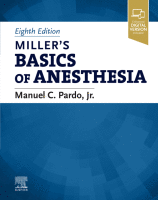Physical Address
304 North Cardinal St.
Dorchester Center, MA 02124

NUTRITIONAL DISORDERS Obesity Obesity is a condition characterized by excessive accumulation and storage of adipose tissue. Obesity is most commonly quantified by body mass index (BMI), the ratio of a person's weight (in kilograms) to the square of their height…

RENAL DISEASE Normal renal function is important for the excretion of anesthetics and medications, maintaining fluid and acid–base balance, and regulating hemoglobin levels in the perioperative period. Renal disease is quite prevalent in patients presenting for surgery and is associated…

INTRODUCTION Chronic respiratory problems include obstructive and restrictive lung diseases, obstructive sleep apnea (OSA), and pulmonary hypertension. Obstructive lung diseases are commonly divided into reactive airway disorders (asthma) and chronic obstructive pulmonary disease (COPD). However, many patients have more than…

Cardiovascular disease is the leading cause of global death, with an estimated 17 million deaths per year; it is also the leading cause of death in the United States. Many of the risk factors identified to predict perioperative mortality are…

The practice of transfusing blood has been around for centuries. The science of transfusion medicine started in the early twentieth century with the discoveries of human blood types and sodium citrate. Human blood typing is the pillar and foundation for…

INTRODUCTION Perioperative fluid administration has two goals: to ensure adequate intravascular volume to maintain cardiac output and tissue perfusion and to prevent electrolyte and acid–base disturbances. Intravenous fluid therapy represents a core element of anesthesia practice, a companion to the…

INTRODUCTION Hemostasis is an ordered process involving cellular and biochemical components that functions to limit blood loss secondary to vascular injury, maintain intravascular blood flow, and promote revascularization after thrombosis. Normal physiologic hemostasis is a constant balance between procoagulant pathways…

~~ The concentrations of hydrogen and bicarbonate ions in plasma must be precisely regulated to optimize enzyme activity, oxygen transport, and rates of chemical reactions within cells. Each day approximately 15,000 mmol of carbon dioxide (which can generate carbonic acid…

Point-of-care ultrasound (POCUS) refers to the use of ultrasound at the patient’s bedside for procedural guidance and/or aid in diagnosis. The use and application of POCUS has rapidly expanded over the past 20 years. POCUS is now routinely used by…

INTRODUCTION Anesthesiologists have long been at the forefront of patient monitoring. This has been of necessity because we are responsible for continuously assessing the patient's physiologic status and the effects of surgery and anesthetic agents. This chapter provides an introduction…